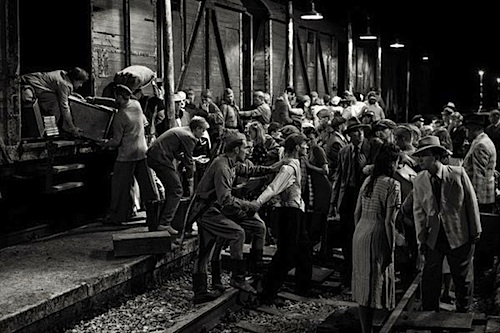By Joe Bendel. It was one of the worst cases of mass murder and ethnic cleansing in recorded history, yet the world never demanded the guilty be held to account. At least 590,000 Estonians, Lithuanians, and Latvians met a premature death as a result of the Soviet WWII era occupation of the Baltics and the resulting mass deportations to Siberia. While many would prefer to ignore the Communist crimes against humanity for ideological reasons, the testimony of survivors like Erna Nagel were an inconvenient indictment of the socialist system. To commemorate the victims, Martti Helde has adapted Nagel’s Siberian diary (written in the form of letters to her beloved husband Heldur) as the extraordinary cinematic hybrid In the Crosswind, which screened during the 18th Annual European Union Film Festival in Chicago.
Nagel’s domestic life with Heldur and their six-year-old daughter Eliide was so blissful, it blinded her to the mounting Soviet danger. Tragically, when the Red Army arrives, Heldur Nagel is one of the first to be rounded up, since he is a member of the Estonian Defense League. He and his colleagues will be sent directly to a gulag, where they will be tortured for months and then executed without trial. Erna and Eliide will be sent to a work camp in Siberia, where Estonian women are forced to perform slave labor. Food rations are meager and only given to adults who meet their quotas. Estonian children like Eliide get nothing (so much for “each according to his need”). Having already contracted dysentery in the over-crowded cattle car that took them east, Eliide will slowly expire from disease and starvation, while Nagel is helpless to comfort her.
Nagel’s own words will tell her story through Laura Peterson’s sensitive voiceovers, but during her period of Siberian exile, they are accompanied by a series of thirteen black-and-white frozen tableaux, in which Helde suspends time for his cast, amid their snarls and cowering. Realized in excruciating detail, cinematographer Erik Pőllumaa slowly surveys each living picture, often revealing greater horrors as his perspective changes. These are not freeze frames, because the wind and elements, as well as ambient noise and background chatter waft through Helde’s carefully composed images. It is a bold aesthetic strategy, but Crosswind cannot be called non-narrative filmmaking, because Nagel’s entire life unfolds through the narration.

While Nagel’s before and after scenes in Estonia are more conventionally live action in their execution, the tableau vivants constitute the guts of the film. Eerily effective, they preclude any possible melodramatic excesses, distilling the essence of the terror and dehumanization of the Communist prison camps and collectives. As Nagel, Peterson does more than hold her poses. Her deeply expressive face speaks volumes and her voiceovers reach into the soul.
There are not a lot of precedents for Crosswind. In some ways, its vibe is somewhat akin to that of German’s Hard to be a God or Majewski’s The Mill and the Cross, but Helde’s film hits viewers on a deeper, more primal level. It is also more urgently topical, given Russian imperialist expansionism in Georgia and Ukraine. This is an exceptional work of cinematic craftsmanship that is viscerally chilling and hauntingly arresting. Very highly recommended, In the Crosswind screened at the Siskel Film Center as part of this year’s Chicago edition of the EUFF.
LFM GRADE: A+
Posted on March 30th, 2015 at 11:00pm.